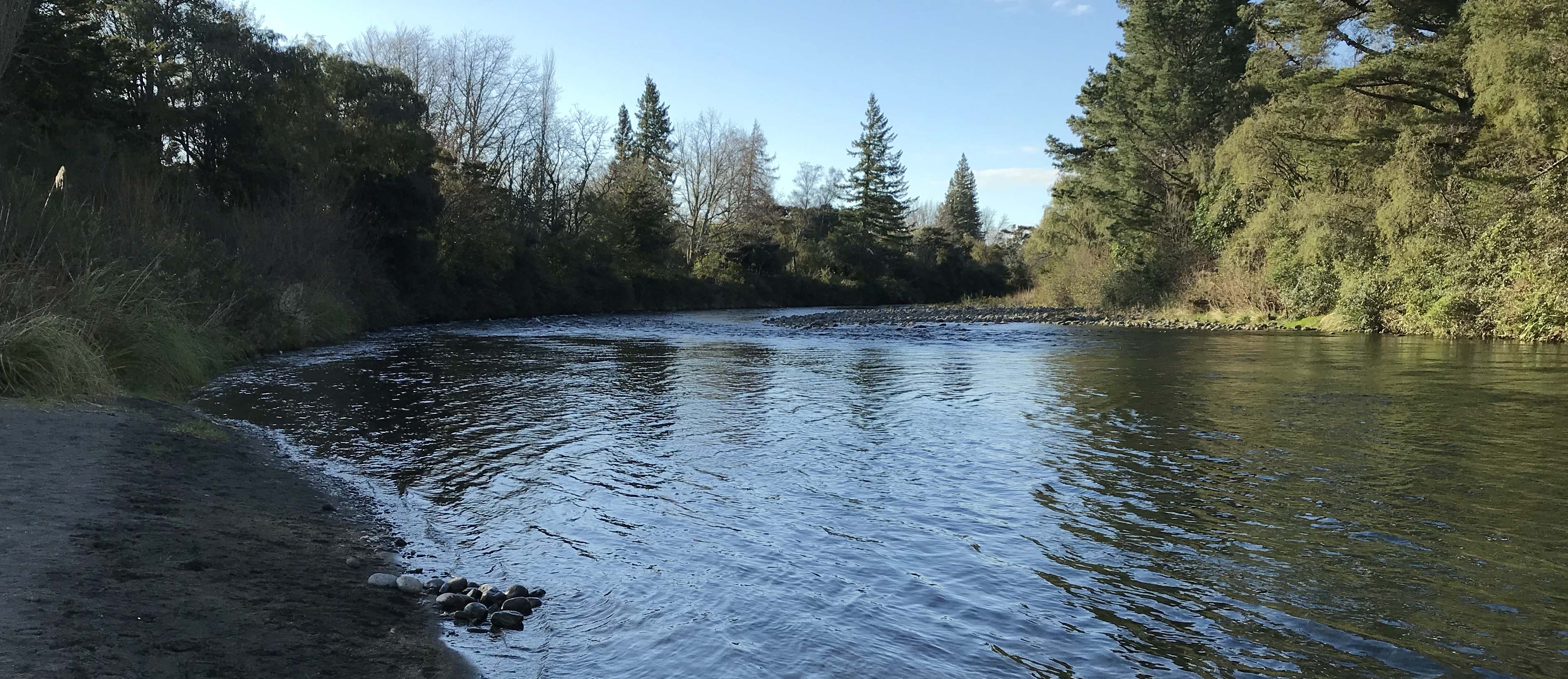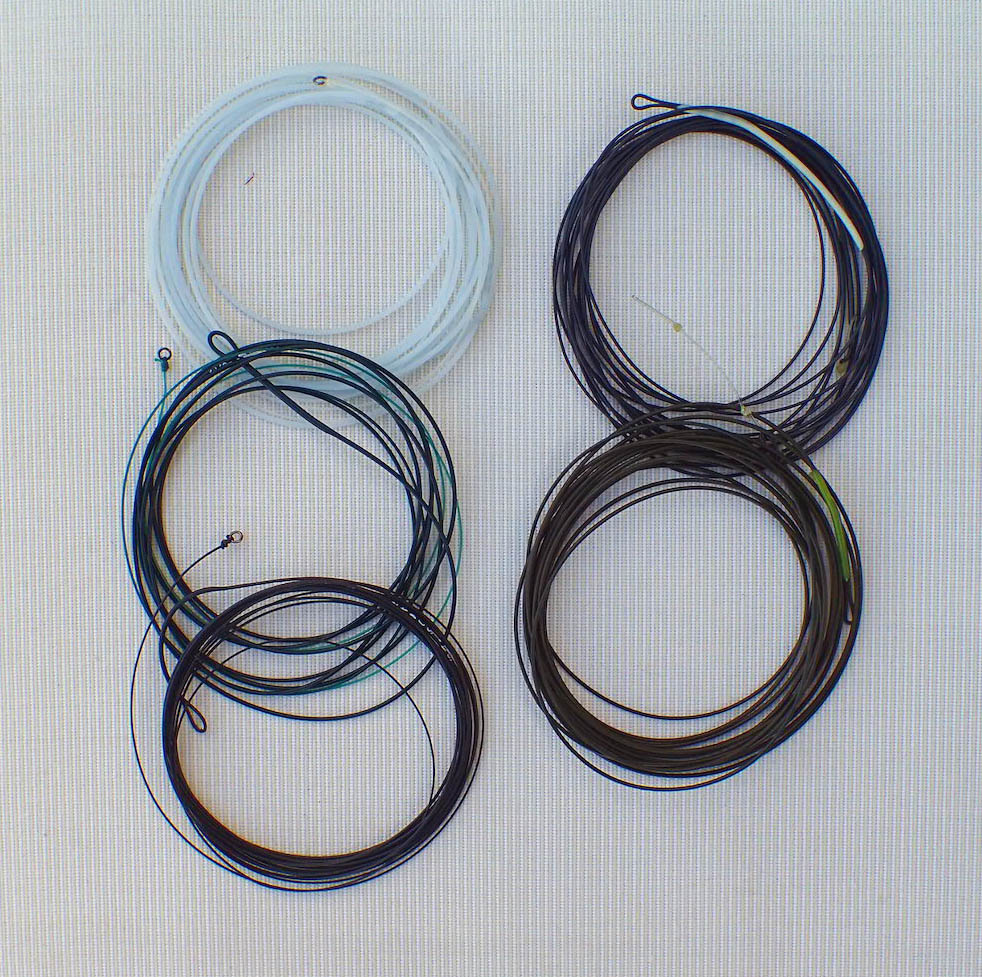What sink tips will work on your Skagit head?
Knowing the heaviest and longest tip a Skagit head can cast is especially important for Trout Spey anglers. We often need to get flies down as deep as possible using relatively light heads. Skagit heads also cast most effectively with sink tips that are an optimal length and weight.
We have all heard that it takes mass to move mass. And that this means heavier tips are required for heavier flies, and heavier Skagit heads are required for heavier tips. We also know that shorter heads will cast longer sink tips on a rod of given length.
But none of this information helps determine the the length and weight of a sink tip that would suit a specific outfit. At best it provides some direction for what has been, for me, an expensive and often frustrating path of trial and error.
Of course we don’t always want to be using the heaviest, fastest sinking tip possible. Light tips are often required to improve presentation with lighter flies. But if a tip is too light, or too short, it won’t provide the line stick required for decent casts.
In this article I give some useful formulae for calculating the lengths and weights of sink tips that should work well for most anglers.
I have dealt with heavy (Level-T) and light (tapered) tips separately, because they perform differently.
Heavy Tips
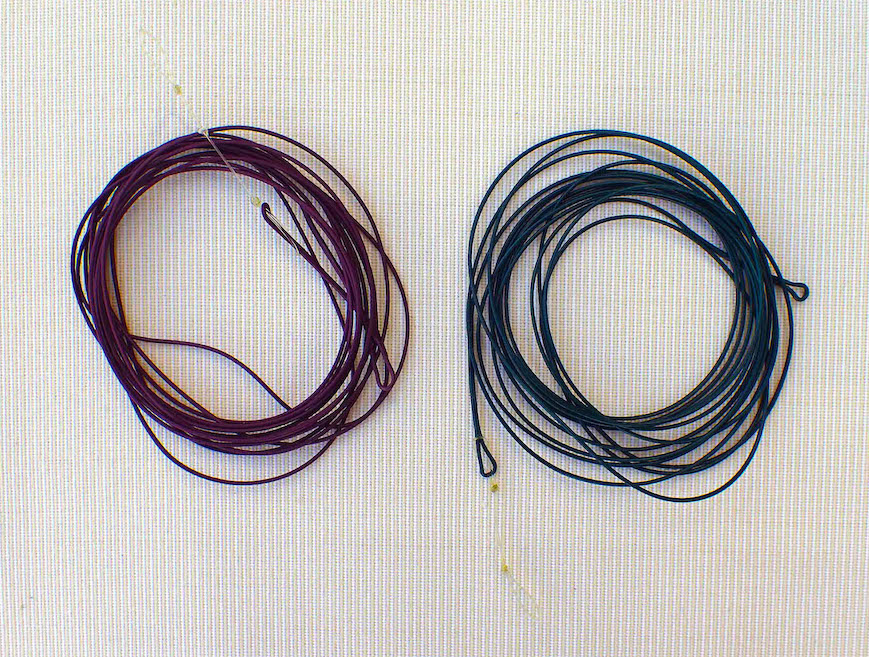
Lengths Rio T-8 (left) and T-11 (right) have become the gold standard for heavy Trout Spey sink tips
Optimum weight
When it comes to heavy tips for Skagit heads, Level-T is the standard. Level-T sink tips consist of a level length of fly line with a tungsten impregnated coating. 'T’ stands for tungsten and the number, e.g. T-7, T-8, T-10, T-11 and T-14, refers to the number of grains per foot. Sink rate increases with grains per foot and the weight of the sink tip is calculated by multiplying the T-value by the length of tip. A 10 ft T-8 sink tip would therefore have a weight of close to 80 grains.
Rules of thumb for sink tip grain weights based on the weight of a Skagit head are not that reliable, because a short Skagit head of a given weight will cast heavier and longer tips than a longer head - it is the number grains per foot that give the Skagit head its power.
After testing many Skagit heads of 150 to 375 grains with a wide variety of sink tips on single hand and two handed rods I came up with the following formula to estimate the maximum weight for level-T sink tips for a Skagit head that most anglers would be comfortable with:
OTW = HW/HL x Ln(HW),
where HW is head weight in grains, HL is head length in decimal feet, and Ln is the natural logarithm. OTW = Optimal Tip Weight.
Estimates are give or take 5% and the formula applies as long as the tip on the Skagit head is thick enough to turn over the calculated weight. Experienced casters will be able to push each tip weight estimate by a further 10 or 20%.
Optimum length
Having determined the weight of tip a Skagit head can cast, the next step is usually to work out how long this should be.
There are three rules I have found useful for determining the ideal length of Level-T sink sink tips for an outfit:
1. (Sink Tip length + Head length) / rod length = 2.3-2.4
2. Tip length should not exceed rod length, regardless of ratio.
3. Tip weight should not exceed OTW (above) by >10%
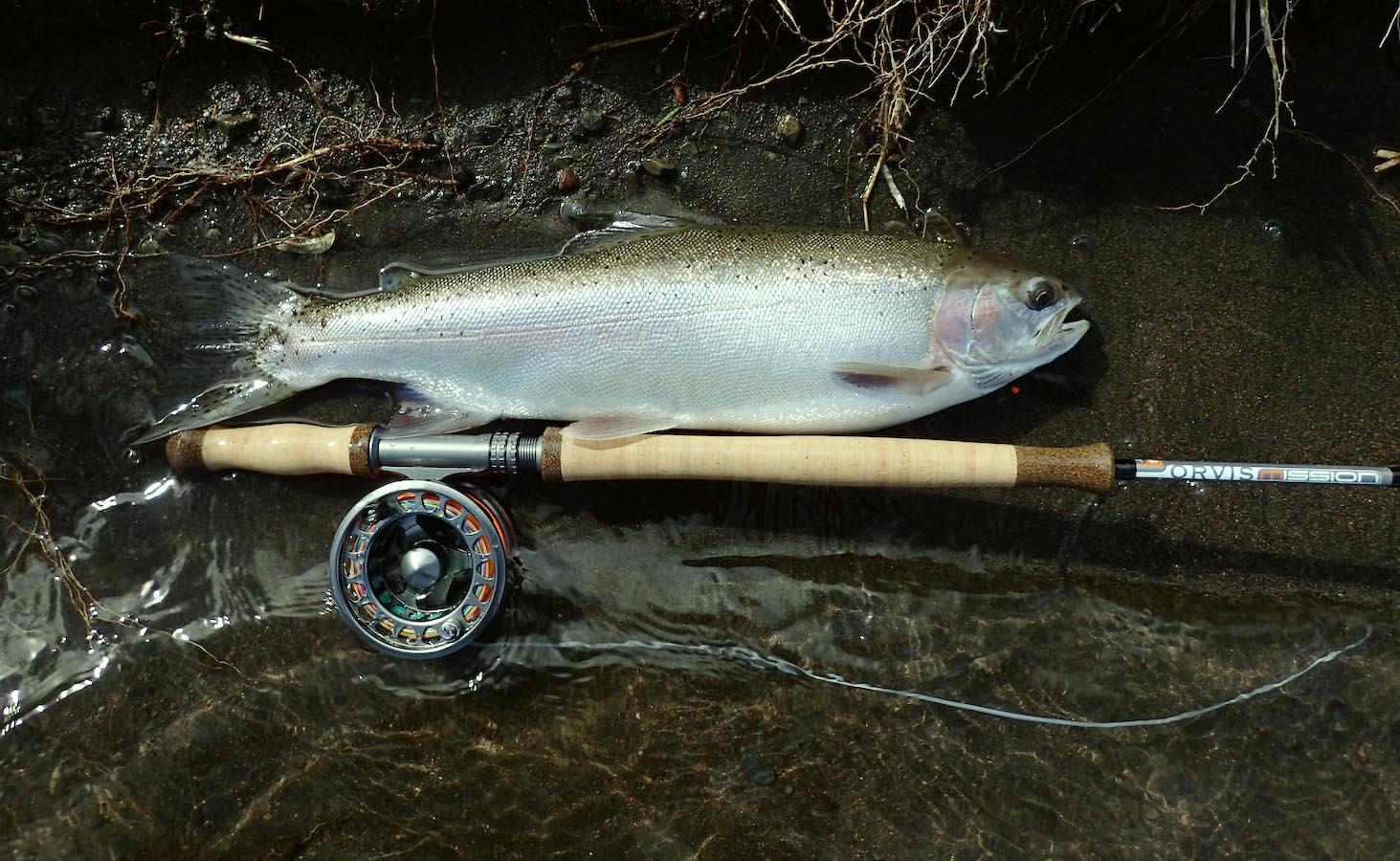
Winter Rainbow: Ten feet of Rio T-11 is my standard double-hand sink tip for the Tongariro in winter
Compound Tips
Compound tips, such as Airflo Flo and Rio MOW and iMOW tips, consist of a butt section of floating or intermediate material and a front section of Level-T. They cast very differently to a straight length of level-T because the floating/intermediate butt section becomes part of the Skagit head and does not contribute to the anchor. For this reason only the level-T portion should be used for estimating the effective length and weight of these tips, based on the equations discussed in this article.
It follows that the length and weight of the floating or intermediate butt section should be added to the Skagit head when calculating optimal sink tip weight and length that the head can cast. A further consideration when using these tips is that the diameter of the butt section should match the tip of the Skagit head for smooth energy transfer.
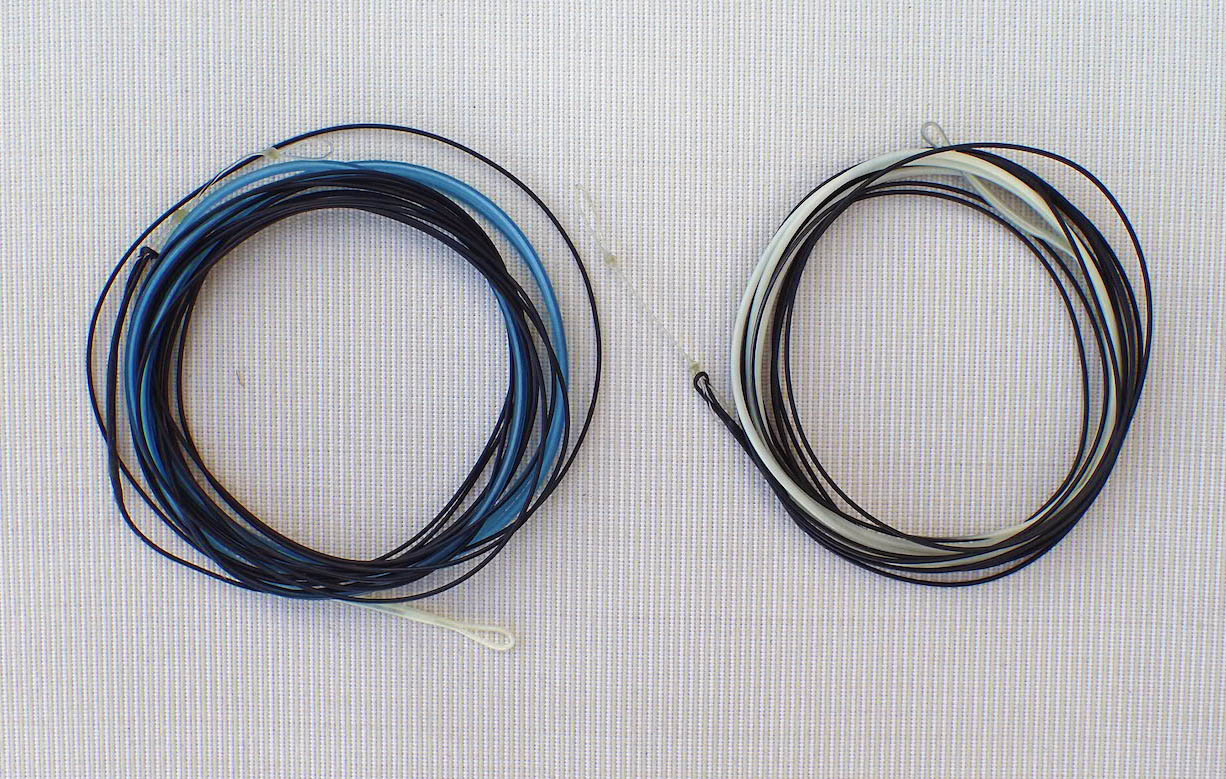
Airflo Flo (left) and Rio iMOW (right) are examples of compound tips. Both examples have 2.5 fit intermediate butt sections with 7.5 ft of T-7 or T-8
The table below provides the Optimum Tip Weight (OTW in grains) and Optimum Tip Length (OTL in feet), based on a tip + head to rod length ratio of 2.4, for heavy tips for Skagit heads I have tested on 9 -12 ft rods. The OTL value is calculated by applying rules 1 and 2 (above). Also provided is the maximum T-value suitable for the OTL, as well as compound factory tips that work. HL is Head Length (ft) and HW is head weight (grains). TC = Scientific Anglers TC Tip, Flo = Airflo Flo Tip.
The 10 ft OPST medium bucket tip is a great Trout Spey option because, in theory, you get T-14 sink rate (8-9 inches per second [ips]) with T-11 weight. A mate of mine was surprised to find that he achieved a consistently deeper swing with 10 ft of Airflo T-10, which has a listed sink rate of 8 ips, than with the medium OPST bucket tip I persuaded him to purchase. The reason for this counter-intuitive observation lies in the diameter of the sink tips. The Airflo T-10 sink tip is considerably thinner than the OPST tip. Although the OPST tip may sink a bit faster in still water, because it has a greater surface area it experiences a greater upward force from flowing water, so will not stay as deep on the swing. I recently fished the 110 grain OPST bucket tip alongside 10 ft of Rio T-11 during several days on the Tongariro River, and found no detectable difference in sink rate in flowing water when fished on the same pools. The T-11 has a sink rate of 7-8 ips (versus 8-9 ips), but because it is slightly thinner than the Bucket Tip it achieved the same depth in moving water. The moral of the story is that the thinner of two sink tips, of comparable length and advertised sink rate, will sink faster and remain deeper on the swing.
When rivers are up, dirty trout often move into slower shallower water, and if you are using medium to larger streamers a heavy sink tip with slower sink rate is required. Another time a slower sinking tip is called for is when swinging streamers at night in summer.
Since I like 10 ft Level-T sink tips on 11-12 ft two handed rods, 80 grain OPST riffle (S2) and run (S4) tips and RIO light (80 grain) 3D MOW tips in S1/S2/S3 and S3/S4/S5 are great options when a slower sink weight is required. I favour the 3D MOW tips because, being triple density, they cast more smoothly and with better presentation. They also have less stretch. Eighty grain 10 ft tips create less splash than 110 grain tips with the same sink rate, which can be an advantage on slow shallow water - this means choosing the light over medium series for OPST and 3D MOW options. Standard MOW tips with the back half floating and the front half sinking, are great for dropping flies into slots or weaving them between boulders, but they are not as effective in areas of even depth or flow. They also do not cast as smoothly as the 3D MOW tips. I like the 8 ft 80 grain Scientific Anglers TC tips in S2/S4 and S3/S5 on single handed rods of 9-9.5 ft, with Skagit heads of 210 to 275 grains.
The following are heavy sink tips I found to be suitable for Trout Spey: Custom Cut tips (Level T): Both Airflo and Rio market lengths of level-T material consisting of a non-stretch core with a tungsten impregnated coating from which level custom sink tips can be custom cut. They come in weights T-7 to T-18, the number indicating the weight in grains per foot. Sink rates are around 6.5 inches per second for T-7/8 and 7.5 ips for T-10/11, which are the weights most commonly used on for micro-Skagit heads. Rio Level-T material welds best and has proven to be incredibly durable. OPST Micro Tips: OPST has led the single hand and micro-Skagit revolution, so it's not surprising they recently came out with 5 ft, 7.5 ft and 10 ft micro sink tips, designed by Ed Ward – with 5 ft and 7.5 ft lengths specifically for single hand rods - and manufactured by RIO. The single-hand micro sink tips are produced in three sink rates: riffle (2 ips), run (4 ips) and bucket (6 ips). The 5 ft sink tips all weigh 40 grains and the 7.5 ft tips all weigh 60 grains, regardless of sink rate. The bucket tips have similar dimensions and performance to equivalent lengths of level T-8, except that they have more stretch than Airflo and Rio products. The 10 ft OPST tips come in light (80 grains), medium (110 grains) and heavy (140 grains). The cool thing about the medium bucket tip is that it sinks at 8-9 ips, which is faster than a 10 ft length of T-11 (7-8 ips). Airflo Flo Tips: Flo tips are compound tips either 10 ft or 12 ft long and are built on a non-stretch 30 lb core with a polyurethane coating. The first 2.5 ft is thicker intermediate material, followed by a 0.8 ft section of tapered sink material, with the remainder being level-T material in T-7, T-10, T-14, or T-18. The thick butt and taper smooth energy transfer during casting, reducing kick, increasing distance and improving presentation. And since the intermediate butt section sinks, albeit it slower than the level-T, it reduces hinging on the water, ‘digs in’ to slow the swing, and fishes flies deeper than 7.5 ft of Level-T. Ten ft Flo Tips are ideal for single hand Skagit. Flo tips work especially well on short Skagit heads with thick tips, e.g. Airflo Skagit Scout. Rio MOW and iMOW Tips: Ten foot MOW tips are produced in three weight-based series: light (T-8), Medium (T-11) and Heavy (T-14). There are five options within each of these series, depending on the relative proportions of floating and sinking material: 1) full floating, 2) front quarter sinking, 3) front half sinking, 4) front three-quarters sinking, and 5) full sinking. The iMOW tips are similar, except that the floating portion is exchanged for intermediate. An iMOW tip with the front 7.5 ft sinking is therefore very similar to a 10 ft Airflo Flo tip, except that the intermediate section is not as thick and the taper to the T-material is around 0.1 ft as opposed to 0.8 ft. The iMOW tips are also significantly lighter than the Flo tips of equivalent sink rate, e.g. my iMOW light (T-8) is 90 grains while my Airflo T-7 Flo tip is 114 grains. Twenty grains in tip weight is a big deal on a 175 grain Skagit head. The full sinking version of the MOW and iMOW series is basically a length of level-T material with welded loops at each end, and is therefore identical to a 10 ft custom-cut tip in equivalent weight (i.e. T-designation). Rio 3D MOW Tips: Ten foot 3D MOW tips are, like the original MOW tips, produced in three weight options: light (80 grains,) medium (110 grains) and heavy (140 grains).But the similarity ends there. The 3D stands for triple density as each tip is divided into three parts of increasing density, and within each weight category there are three options: intermediate/sink3/sink4; sink3/sink4/sink5; and sink5/sink6/sink7. While the purpose of the density compensation is to reduce hinging and sagging during the swing, the progressively increasing density, and corresponding decreasing diameter, results in easier pick-up, a smoother cast and better presentation than with a 10 ft length of level-T. I recommend the light series for Trout Spey. Scientific Anglers TC Tips: TC tips are fully tapered to improve turn over, they are textured to reduce line stick and most sinking options are dual density to reduce hinging. They come in three separate separate series: 8 ft 80 grain, 10 ft 120 grain and 12 ft 160 grain; and the following sink rates are available within each series: floating, S1/S2, S2/S4, S3/S5 and S7. All options within a series have the same weight. Taper becomes more pronounced and butt sections become thicker with decreasing sink rate. The S7 tips are not dual density, and the taper is slight. The 8 ft tips are most suitable for Trout Spey, and work well on single hand rods.
What are light sink tips? Light sink tips weigh around 50-75% of the OTW value calculated for a Skagit head. They are usually used with lightly weighted flies in shallower water or smaller streams, because they provide better presentation than heavy tips. Lightly weighted flies do not require the weight of a Level-T tip to turn them over. In the Trout Spey arena light tips usually consist of coated leaders (AKA Polyleaders) and Rio Replacement Tips. Since light tips provide less line stick per foot, they are usually longer than the heavy sink tips appropriate for a particular outfit. The recommended Skagit head plus sink tip to rod length ratio for light tips is 2.5-2.8 (vs 2.3-2.5 for heavy tips). Light tips longer than a rod work fine.
Coated leaders consist of a level monofilament core with a tapered coating of polyurethane or PVC. They are nowadays available in a mind boggling range of lengths, thickness, breaking strains and sink rates, for everything from trout to salmon to saltwater predators. Heavier coated leaders (i.e. Salmon/Steelhead or Spey) of around 50 grains are usually recommended for Skagit heads because the lighter versions do not provide enough line stick. Rio Replacement Tips span the gap between coated leaders and level sink tips. They are built on low stretch braided cores (instead of monofilament), they have welded loops at both ends, and an approximately 3 ft front taper. The 10 ft Replacement Tips come in line ratings 5-9 and grain weights 55-95 grains, and within each line weight there are four sink rates: floating, 1.5-2 ips, 3-4 ips and 6-7 ips. All sink rates for a particular line rating have the same grain weight, e.g. the 5 wt tips all weigh around 55 grains and the 6 wt tips weigh around 65 grains, and so on. Both coated leaders and Replacement Tips are tapered, which assists with turning over and ‘delicately’ presenting light flies.The advantage of Replacement Tips is that the S3 (3ips) and S6 (6ips) versions are density compensated so the tips sink at the same rate as the butt sections, which can be an issue with coated leaders. Ten foot Replacement Tips are a great option for Skagit Heads that are too long to cast a heavy tip longer than 7.5 ft on a 9 ft single hand rod. Sticking to the tip line rating that corresponds with the line rating on the rod will ensure the tip remains light enough to cast, e.g. #5 (55 grain) Tips for a 5wt 9 ft rod. When using 9 ft single hand rods, I like 5wt 10 ft S6 Replacement Tips on 150 grain Skagit heads shorter than 12.5 ft (e.g SA Skagit Lite), and on 175 - 200 grain heads longer than 14 foot, e.g. Airflo Scout and Rio Skagit Trout Spey. Scientific Anglers Sonar leaders, which all weigh 50 grains regardless of sink rate, are the best bet for 150 grain Skagit heads longer than 12 ft. Skagit heads that can cast 9 ft of T-8 on a 9 ft single handed rod, will also cast #6 Replacement Tips on the same outfit. By way of example I often use a #6 Replacement tip on a 180 grain Skagit Lite on my 5 wt single hand rods.
Skagit Head Sink Tip Chart
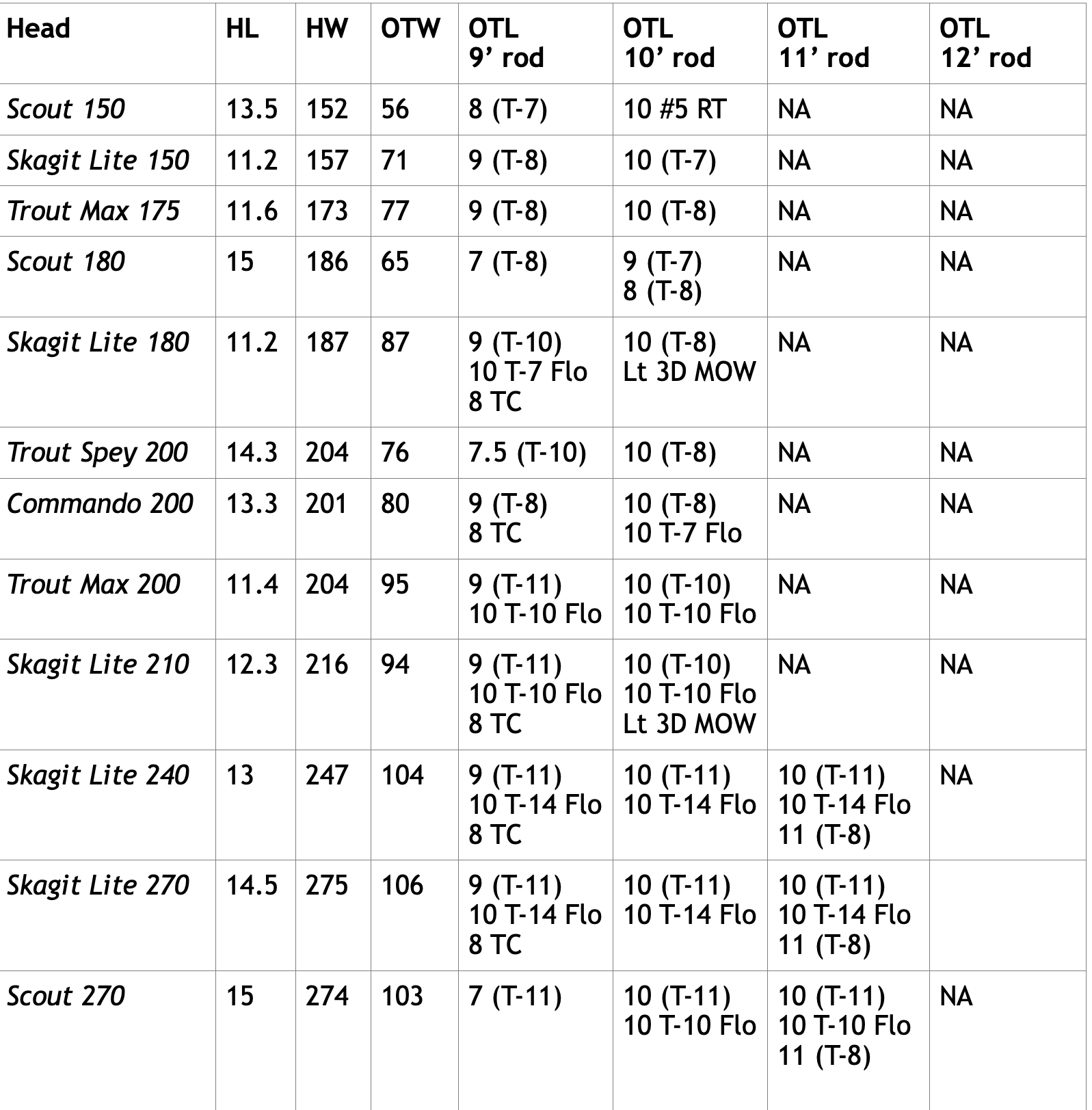
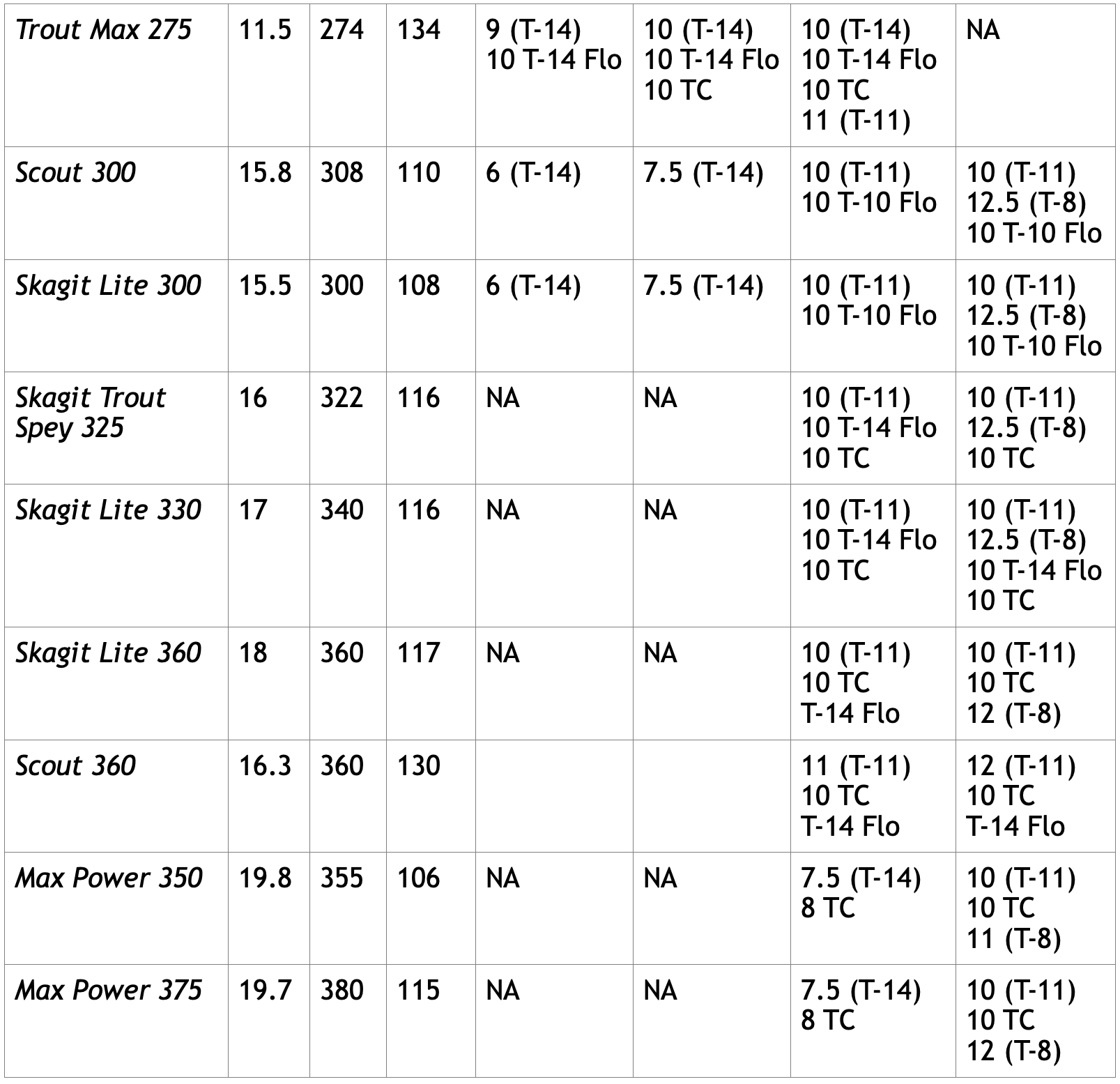
Sink rate and sink tip thickness
Heavy sink tips with slower sink rate
Tongariro brown trout caught at night swinging a streamer on a floating head with a S3/S4/S5 3D MOW tip
Heavy Sink Tips Available in 2022
1.
2.
3.
4.
5.
6.
Light Sink Tips
Light tip options
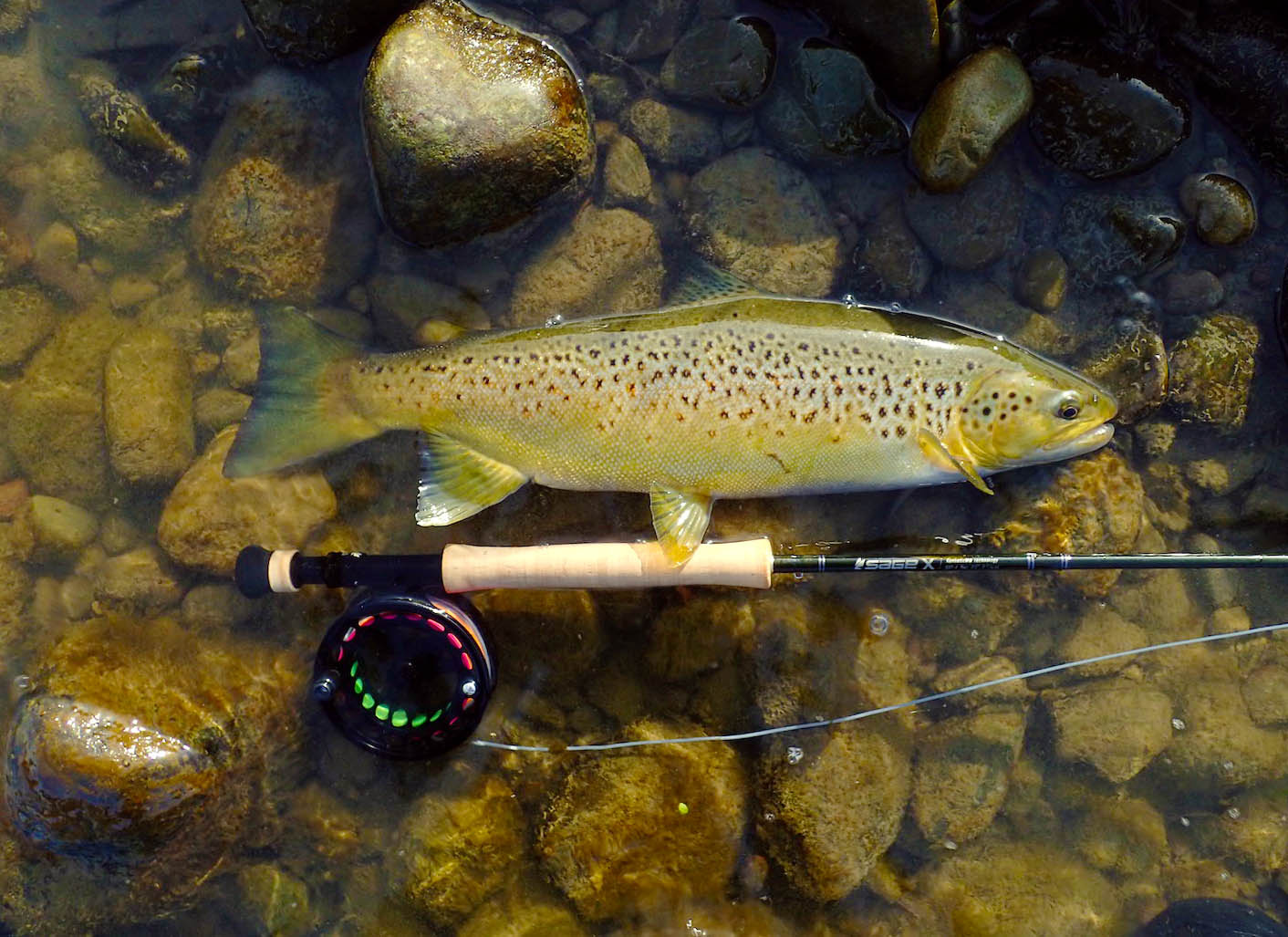
This Manawatu River brown trout was caught using a single hand rod and a #6 S6 Replacement Tip on a 180 grain Skagit Lite head
Size 5 and 6 Replacement Tips will happily turn over small tube flies and weighted woolly buggers up #6, but they don’t turn over heavy flies as well as level-T sink tips.
Some anglers use intermediate coated leaders for fishing soft hackles on Skagit heads. I have found that looping on a compact Scandi head, such as the SA Scandi Lite or Rio Trout Spey, and tapered mono leader to be almost as quick but much more effective and a lot more fun. But for those who don’t want to purchase an extra head, coated leaders will get the job done.
Coated leaders (left) and Rio Replacement tips (right)
What is Trout Spey |
|
| + | How it all began |
| + | What is Spey casting? |
| + | Fly lines |
| + | Single versus two handed rods |
| + | Favourite Trout Spey outfits |
| + | Conclusions |
Single Hand Skagit - Science behind the magic |
|
| + | Where it all began |
| + | Head design |
| + | Sink tips |
| + | Casting heavy sink tips |
| + | Running lines |
| + | Reels |
| + | Rods |
| + | Intermediate heads |
| + | Favourite outfits |
| + | Conclusions |
| + | Casting Notes for 12 Skagit Heads I tested |
| + | Table of Sink Tip Recommendations |
| + | Table of Lengths and Weights of Sink Tips |
Single hand Trout Spey : Getting started with a 9 ft 5wt rod |
|
| + | Getting started |
| + | Rods and Skagit heads |
| + | Sink tips for Skagit heads |
| + | Tippet for Skagit heads |
| + | |
| + | Hybrid heads |
| + | Floating tips for Skagit heads |
| + | Running lines |
| + | Cost effective approach |
| + | Learning to Spey cast |
| + | A final word |
